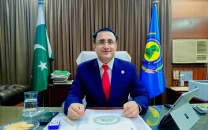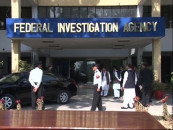Children are like vacuum cleaners, they will put anything in their mouths: poison expert
Our households have nearly 100 types of poisons in children’s reach.
By the time you finish reading this article at least two people will end up in an emergency room with a case of poisoning.
There would have been 20 cases by the end of toxicology guru Dr Nadeemullah Khan’s presentation at the Aga Khan University Hospital emergency medicine seminar on Wednesday. His math is simple: In Pakistan there are about 600,000 cases per year of unintentional and intentional poisoning, which if calculated means 1,643 cases a day, 70 per hour. “One of the most common sources of poisoning in Pakistan is pesticide,” he said. In 2003, there were about 780 deaths related to wheat pills, a kind of pesticide used by farmers. Sadly, though, there are only two poison control centres in Pakistan, in Karachi and Faisalabad.
For Dr Najma Khan of Emory University School of Medicine, one pill can kill. “It is important for us to understand that children are not young adults. They are like vacuum cleaners and will put anything in their mouths. More than 52% of 2.5 million deaths which occur as a result of toxic exposure are children,” she said.
For her, the villains are pain and heart medication and opioids such as Lomotil, used to treat diarrhoea.
Also on Khan’s hit lists are pain-relieving balms, such as Tiger Balm avidly promoted by celebrity golfer Tiger Woods. “Products such as Tiger Balm are very popular in South Asian countries, it consists of aspirin and Oil of Wintergreen which is harmful for children. Even, sinus-relieving balms such as Vicks Vaporub are harmful,” she said. One tablet of Lomotil can severely harm the child or nearly kill him, imagine what the other things can do.
Dr Mueed Ahmed from the King Albert Edward Infirmary, a district general hospital in Greater Manchester, UK, elaborated on Khan’s point. There are at least 100 kinds of poisonous items which can be found at home. He gave the example of a toy popular with children. “Thomas the tank, a popular cartoon produced a toy with a high lead content. The product was removed from toy stores and homes as it had caused lead poisoning.” A classic example of unintentional poisoning is alternative medicine. People go to the hakeem for medicine to gain strength and are usually prescribed ‘kustas’ which can cause poisoning upon consumption.
Roads
The audience was also bombarded with figures on accidents. Data shows that there are more than 1,227 trauma-related fatalities in Karachi but official statistics only show 491, said Dr Rashid Jooma. Data helps identify black spots.
Research has helped save lives. In 2007, a high number of municipal road cleaners were injured due to low visibility during the early and late hours of the day. This problem was solved with the help of the CDGK who, on Jooma’s team’s suggestion, provided the workers with glow-in-the-dark orange jackets.
Part of the problem is that the CDGK invested in roads, bridges and flyovers to minimise traffic but ignored pedestrians and motorcyclists. Jooma’s team helped the CDGK fix the sharp turns on the Shaheed-e-Millat expressway which now has rumble strips and signs.
The CDGK also cleaned up the dust on the Karachi Port Trust flyover, where the curve leading to Queens Road is steep and dangerous for motorcyclists who were drifting to the other side and losing all balance.
One of the most underestimated evils of roads are the dug and forgotten pits and underpass ledges. Many people were found dead in the underpass, mainly because they slept on the ledges and died when they turned over.
Jooma’s team is working on the ill-lit Korangi Naddi. “We have sent the CDGK a proposal highlighting these facts but the situation gets tricky as that area does not fall under its political radar,” he said. “It was much easier to achieve these changes in Shahrah-e-Usman in Nazimabad where with the help of U-turns and pedestrian bridges, matters have improved drastically.”
Dr Adnan Hyder of Johns Hopkins University pointed out that more than nine per cent of fatalities are a result of road accidents and trauma, which is higher than that of HIV.
Quality of care in emergency department
The session on emergency departments was chaired by Jinnah hospital ER chief Dr Seemin Jamali and Dr Nadeem Mustafa Khan. Dr Munawar Khursheed of AKUH talked about ways to reduce ER overcrowding, which puts pressure on staff regardless of their proficiency, leading to a high risk environment for medical error. It delays identification and treatment of time-sensitive cases. Investigations in Australia, Spain and the US all find a link between ER and hospital crowding and death rates. Electronic medical records (EMRs) are one solution.
Dr Rashid Sohail, an ER physician from the UK, talked about medical negligence.
The standard of care has been defined by several courts over the centuries, he said, explaining that in the UK a person will be regarded as negligent if (s)he fails to act according to the defined standard, even if it is more difficult for him as an individual to do so than others. Therefore, the UK medical system is including law as part of graduate studies.
Emergency Medicine consultant Dr Ziauddin Hassan with the Fairfield General Hospital in Manchester stressed reducing diagnostic errors in the ER.
A 1991 Harvard Medical Practice study said that of 30,121 randomly selected patient charts in 1984 from 51 New York hospitals researchers found that disability occurred in 3.7% of hospitalisations and 69% of injuries were caused by errors.
Published in The Express Tribune, June 23rd, 2011.



















COMMENTS
Comments are moderated and generally will be posted if they are on-topic and not abusive.
For more information, please see our Comments FAQ